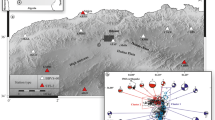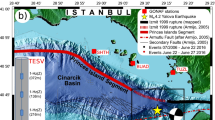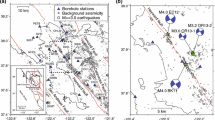Abstract
We consider whether mm-scale earthquake-like seismic events generated in laboratory experiments are consistent with our understanding of the physics of larger earthquakes. This work focuses on a population of 48 very small shocks that are foreshocks and aftershocks of stick–slip events occurring on a 2.0 m by 0.4 m simulated strike-slip fault cut through a large granite sample. Unlike the larger stick–slip events that rupture the entirety of the simulated fault, the small foreshocks and aftershocks are contained events whose properties are controlled by the rigidity of the surrounding granite blocks rather than characteristics of the experimental apparatus. The large size of the experimental apparatus, high fidelity sensors, rigorous treatment of wave propagation effects, and in situ system calibration separates this study from traditional acoustic emission analyses and allows these sources to be studied with as much rigor as larger natural earthquakes. The tiny events have short (3–6 μs) rise times and are well modeled by simple double couple focal mechanisms that are consistent with left-lateral slip occurring on a mm-scale patch of the precut fault surface. The repeatability of the experiments indicates that they are the result of frictional processes on the simulated fault surface rather than grain crushing or fracture of fresh rock. Our waveform analysis shows no significant differences (other than size) between the M -7 to M -5.5 earthquakes reported here and larger natural earthquakes. Their source characteristics such as stress drop (1–10 MPa) appear to be entirely consistent with earthquake scaling laws derived for larger earthquakes.








Similar content being viewed by others
References
Aagaard, B. T., Knepley, M. G., and Williams, C., A. (2013) A domain decomposition approach to implementing fault slip in finite-element models of quasi-static and dynamic crustal deformation. J. Geophys. Res., 118, 3059–3079.
Abercrombie, R. E., (1995) Earthquake source scaling relationships from −1 to 5 ML using seismograms recorded at 2.5-km depth, J. Geophys. Res., 100, 24015–24036.
Aki, K., (1967) Scaling law of seismic spectrum, J. Geophys. Res., 72, 1217–1231.
Beeler, N. M., Kilgore, B., McGarr, A., Fletcher, J., Evans, J., and Baker, S. R. (2012) Observed source parameters for dynamic rupture with non-uniform initial stress and relatively high fracture energy, J. Struct. Geol., 38, 77–89.
Boettcher, M. S., A. McGarr, and M. Johnston (2009), Extension of Gutenberg-Richter distribution to M w –1.3, no lower limit in sight, Geophys. Res. Lett., 36, L10307, doi:10.1029/2009GL038080.
Brace, W. F. and J. D. Byerlee (1966) Stick slip as a mechanism for earthquakes, Science, 153, 990–992.
Brune, J. N., (1970) Tectonic stress and spectra of seismic shear waves from earthquakes, J. Geophys. Res. 75, 4997–5009.
Dieterich, J. H., (1981), Potential for geophysical experiments in large scale tests, Geophys. Res. Lett., 8, 653–656.
Dahm, T. (1996) Relative moment tensor inversion based on ray-theory: theory and synthetic tests, Geophys. J. Int. 124, 245–257.
Ellsworth, W.L., Hickman, S.H., Zoback, M.D., Imanishi, K., Thurber, C.H., Roecker, S.W. (2007) Micro- Nano- and Picoearthquakes at SAFOD: Implications for Earthquake Rupture and Fault Mechanics: Eos (Transactions, American Geophysical Union), v. 88, no. 52, supplement, abstract S12B-05.
Grosse, C., Reinhardt, H, and Dahm, T. (1997) Localization and classification of fracture types in concrete with quantitative acoustic emission measurement techniques, NDT & E International 30, 223–230.
Grosse, C., and Ohtsu, M. Acoustic Emission Testing (Springer-Verlag: Berlin 2008).
Gibowicz, S. J., Young, R.P., Talebi, S., and Rawlence, D. J. (1991) Source parameters of seismic events at the Underground Research Laboratory in Manitoba, Canada: Scaling relations for events with moment magnitude smaller than −2, Bull. Seismol. Soc. Am., 81, 1157–1182.
Goebel, T., Becker, T., Schorlemmer, D., Stanchits, S., Sammis, C. Rybacki, E., and Dresen. G. (2012) Identifying fault heterogeneity through mapping spatial anomalies in acoustic emission statistics, J. Geophys. Res., 117, B03310.
Hsu, N. (1985), Dynamic Green’s functions of an infinite plate—A computer program, Tech. Rep. NBSIR 85–3234, Cent. for Manuf. Eng., Natl. Bur. of Stand., Gaithersburg, Md.
Imanishi, K., and W. L. Ellsworth (2006), Source scaling relationships of microearthquakes at Parkfield, CA, determined using the SAFOD Pilot Hole Seismic Array, in Earthquakes: Radiated Energy and the Physics of Earthquake Faulting, Geophys. Monogr. Ser., vol. 170, (ed Abercrombie, R. et al.), pp. 81–90, AGU, Washington, D. C.
Ide, S. and Beroza, G. (2001) Does apparent stress vary with earthquake size? Geophys. Res. Lett. 28, 3349–3352.
Ide, S., Beroza, G., Prejean, S., Ellsworth, W. (2003) Apparent break in earthquake scaling due to path and site effects on deep borehole recordings, J. Geophys. Res. 108, B5, 2271.
Jost, M. L., Büßelberg, T., Jost, Ö., and Harjes, H.-P. (1998) Source parameters of injection-induced microearthquakes at 9 km depth at the KTB deep drilling site, Germany, Bull. Seismol. Soc. Am., 88, 815–832.
Kwiatek, G., Plenkers, K., Nakatani, M., Yabe, Y., Dresen, G., and JAGUARS-Group (2010) Frequency-magnitude characteristics down to magnitude -4.4 for induced seismicity recorded at Mponeng gold mine, South Africa, Bull. Seismol. Soc. Am. 100, 1165–1173.
Kwiatek, G., Plenkers, K., Dresen, G. and JAGUARS Research Group (2011) Source parameters of picoseismicity recorded at Mponeng deep gold mine, South Africa: implications for scaling relations, Bull. Seismol. Soc. Am. 101, 2592–2608.
Linzer, L. (2005) A relative moment tensor inversion technique applied to seismicity induced by mining, Rock Mech. Rock Engng. 38 (2), 81–104.
Lockner, D. A., P. G. Okubo, and J. H. Dieterich (1982) Containment of stick slip failures on a simulated fault by pore fluid injection, Geophys. Res. Lett., 9, 801–804.
Lockner, D. A., (1993) Role of acoustic emission in the study of rock fracture, Int. J. Rock Mech. Min. Soc. Geomech. Abstr., 30, 884–899.
Manthei, G. (2005). Characterization of acoustic emission sources in a rock salt specimen under triaxial compression, Bull. Seismol. Soc. Am. 95, 1674–1700.
Maxwell, S. C., J. T. Rutledge, R. Jones, and M. Fehler (2010) Petroleum reservoir characterization using downhole microseismic monitoring, Geophysics, 75, 75A129–75A137.
McGarr, A. (1984). Scaling of ground motion parameters, state of stress, and focal depth, J. Geophys. Res. 89, 6969–6979.
McGarr, A. (1994). Some comparisons between mining-induced and laboratory earthquakes, Pure Appl. Geophys. 142, 467–489.
McGarr, A., (1999) On relating apparent stress to the stress causing earthquake fault slip, J. Geophys. Res., 104, 3003–3011, 1999.
McGarr. A., (2012) Relating stick–slip friction experiments to earthquake source parameters, Geophys. Res. Lett., 39, L05303.
McGarr, A., and Fletcher, J. B. (2003) Maximum Slip in Earthquake Fault Zones, Apparent Stress, and Stick–Slip Friction. Bull. Seismol. Soc. Am. 93, 2355–2362.
McLaskey, G., and Glaser, S. (2010) Hertzian impact: experimental study of the force pulse and resulting stress waves. J. Acoust. Soc. Am. 128, 1087–1096.
McLaskey, G., and Glaser, S. (2011) Micromechanics of asperity rupture during laboratory stick slip experiments Geophys. Res. Lett., 38, L12302.
McLaskey, G. and Glaser, S. (2012) Acoustic Emission Sensor Calibration for Absolute Source Measurements, J. Nondest. Eval. 31, 157–168.
McLaskey. G. and Kilgore, B. (2013) Foreshocks during the nucleation of stick–slip instability, J. Geophys. Res. vol 118, 1–16.
Ohtsu, M. (1991), Simplified moment tensor analysis and unified decomposition of acoustic emission: application to hydrofracturing test, J. Geophys. Res. 96, 6211–6221.
Okubo, P., and Dieterich, J. (1984), Effects of physical fault properties on frictional instabilities produced on simulated faults, J. Geophys. Res., 89, 5817–5827.
Plenkers, K., G. Kwiatek., and F. Krüger (2013) “Monitoring induced seismicity with AE sensors : the influence of unknown calibration functions,” in EGU General Assembly 7–12 April, 2013, Vienna, Austria. Abstract Number EGU2013-3849.
Prejean, S. G. and Ellsworth, W. L. (2001) Observations of earthquake source parameters and attenuation at 2 km depth in the Long Valley Caldera, Eastern California, Bull. Seismol. Soc. Am., 91, 165–177.
Sellers, E. J., Kataka, M. O. and Linzer L. M. (2003). Source parameters of acoustic emission events and scaling with mining-induced seismicity, J. Geophys. Res. 108, B9 2418.
Shah, K., and Labuz, J. (1995) Damage mechanisms in stressed rock from acoustic emission. J. Geophys. Res., 100, 15,527–15,539.
Spottiswoode, S. M. and McGarr, A. (1975) Source parameters of tremors in a deep-level gold mine, Bull. Seismol. Soc. Am. 65, 93–112.
Stanchits, S., Vinciguerra, S., and Dresen, G. (2006) Ultrasonic velocities, acoustic emission characteristics, and crack damage of basalt and granite, Pure Appl. Geophys. 163, 974–993.
Thompson, B. D., Young, R. P. and Lockner, D. A. (2009), Premonitory acoustic emissions and stick–slip in natural and smooth-faulted Westerly granite, J. Geophys. Res., 114, B02205.
Ulrich, T. J., McCall, K. R., and Guyer, R. A., (2002) Determination of elastic moduli of rock samples using resonant ultrasound spectroscopy, J. Acoust. Soc. Am. 111, 1667–1674.
Urbancic, T. Y., and Trifu, C. (2000) Recent advances in seismic monitoring technology at Canadian mines, J. Appl. Geophys. 45, 225–237.
Walter, B. R., Mayeda, K., and Gok, R. (2006) in Earthquakes: Radiated Energy and the Physics of Earthquake Faulting, Geophys. Monogr. Ser., vol. 170, (ed Abercrombie, R. et al.), pp. 25–41, AGU, Washington, D. C.
Zang, A., Wagner, C., Stanchits, S., Dresen, G., Andresen, R., and Haidekker, M. (1998) Source analysis of acoustic emissions in Aue granite cores under symmetric and asymmetric compressive loads. Geophys. J. Int. 135, 1113–1130.
Acknowledgments
This work benefitted from careful reviews by Art McGarr, Annemarie Baltay, and Grzegorz Kwiatek. The authors would also like to thank Brad Aagaard for assistance with the finite element modeling.
Author information
Authors and Affiliations
Corresponding author
Appendix
Appendix
Our estimates of seismic moment and stress drop are dependent on the absolute accuracy of the Green’s functions, so we deemed it worthwhile to verify them by means of finite element modeling. We computed solutions to a 3D finite element model using the software PyLith (Aagaard et al. 2013). Explicit dynamic finite element models useful for the computation of elastodynamic Green’s functions become unstable when the number of elements per wavelength decreases to below about 10. The element size in our model is 3 mm, so the maximum frequency for S waves (v s = 2,700 m/s) that our model can accommodate is about 90 kHz. Figure 9 shows synthetic seismograms obtained from the finite element model (thick grey lines) compared to synthetic seismograms obtained from the generalized ray theory code (black dashed lines) for the source and sensor geometries and orientations shown in Fig. 3. These synthetic seismograms are calculated exactly the same way as those shown in Fig. 3 except the instrument response function is not included and the width t0 of a pulse-shaped moment rate function \( \dot{m}(t) \) is set to 15 μs. This relatively wide pulse width (15 μs, corner frequency ~67 kHz) is required to keep the majority of the wave energy below our 90 kHz band limit, as set by the stability of the finite element model. The two solutions agree during the first part of the signals when only direct P and S waves and near field terms are present, and they diverge at later times due to (1) errors associated with later arriving reflections in the generalized ray theory code, and (2) reflections off the sides of finite element model which are not accounted for in the infinite slab geometry of the generalized ray solution.
Comparison between synthetic seismograms obtained from our finite element model (thick grey lines) and synthetic seismograms obtained from the generalized ray theory code (black dashed lines), for the same source location as the LabEQ shown in Fig. 3 but different source duration. These synthetics include source and wave propagation components but do not include sensor distortions. The source term is a left-lateral strike-slip double couple focal mechanism with pulse-shaped moment rate function \( \dot{m}(t) \) that is 15 μs wide and 85 kNm/s tall. Positive displacement is in the direction outward from the sample
Rights and permissions
About this article
Cite this article
McLaskey, G.C., Kilgore, B.D., Lockner, D.A. et al. Laboratory Generated M -6 Earthquakes. Pure Appl. Geophys. 171, 2601–2615 (2014). https://doi.org/10.1007/s00024-013-0772-9
Received:
Revised:
Accepted:
Published:
Issue Date:
DOI: https://doi.org/10.1007/s00024-013-0772-9





